Home Sweet Brooder, a set on Flickr.
Fragile New Chicks..."Handle With Care"My own photo documentary of bringing my new baby chicks home from the TRACTOR SUPPLY store, showing the equipment I used for the brooder.
I knew NOTHING about raising baby chicks until finding the website and group called
BackYardChickens.com
The online forum became my BEST FRIENDS for months, always there to answer my questions :)
This info below was written by Back Yard Chickens :)
Thanks!
http://www.backyardchickens.com/LC-first60days.html
WHAT is a BROODER?
Definition: A brooder is a temperature and humidity controlled enclosure that bird breeders use to house newly hatched birds and keep them in a safe and warm environment.
General Hints
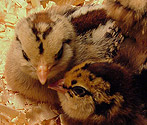 So, now you have cute baby chicks...
So, now you have cute baby chicks...
what now?? The main things to attend to for the first 60 days:
 So, now you have cute baby chicks...
So, now you have cute baby chicks...what now?? The main things to attend to for the first 60 days:
- housing
- temperature
- food and water
- cleanliness
Chicks should be kept indoors (or in a heated brooder) until they have their feathers, about 5-8 weeks.
Brooders
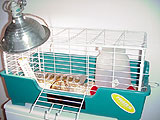 The chicks' first home is called a "brooder". For one-time or once-in-a-while use, a cardboard box works just fine. A cage suitable for a rabbit or guinea pig is terrific and easy to clean (see picture). Some people even use an aquarium! The bottom should have a layer of clean litter (pine shavings or similar) or newspaper.
The chicks' first home is called a "brooder". For one-time or once-in-a-while use, a cardboard box works just fine. A cage suitable for a rabbit or guinea pig is terrific and easy to clean (see picture). Some people even use an aquarium! The bottom should have a layer of clean litter (pine shavings or similar) or newspaper.
 The chicks' first home is called a "brooder". For one-time or once-in-a-while use, a cardboard box works just fine. A cage suitable for a rabbit or guinea pig is terrific and easy to clean (see picture). Some people even use an aquarium! The bottom should have a layer of clean litter (pine shavings or similar) or newspaper.
The chicks' first home is called a "brooder". For one-time or once-in-a-while use, a cardboard box works just fine. A cage suitable for a rabbit or guinea pig is terrific and easy to clean (see picture). Some people even use an aquarium! The bottom should have a layer of clean litter (pine shavings or similar) or newspaper.Newspaper print ink can get the chicks dirty though, so we've never used it, and it can also be slippery. The litter should be changed out every couple of days, and never allowed to remain damp - cleanliness is VERY important at this stage. Baby chicks are prone to a number of diseases, most of which can be avoided with proper sanitation.
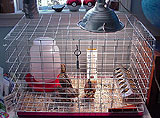 The size of the brooder depends on how many chicks you have - the chicks should have enough room to move around, and to lay down and sleep. You also need to have enough space in it for a waterer and a feeder (see below).
The size of the brooder depends on how many chicks you have - the chicks should have enough room to move around, and to lay down and sleep. You also need to have enough space in it for a waterer and a feeder (see below).When the chicks are a month old, add a low roost - a stick or piece of wood dowelling about 4" off the floor of the brooder. The chicks will jump on it and may even begin sleeping there. Don't put the roost directly under the light, it will be too hot.
Temperature
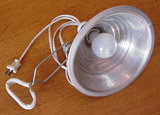 The brooder can be heated by using a light bulb with a reflector, available at any hardware store. A 100-watt bulb is usually fine, though some people use an actual heat lamp. The temperature should be 90-100 degrees for the first week or so, then can be reduced by 5 degrees each week thereafter, until the chicks have their feathers (5-8 weeks old). A thermometer in the brooder is helpful, but you can tell if the temperature is right by how the chicks behave. If they are panting and/or huddling in corners farthest from the light, they are too hot. If they huddle together in a ball under the light, they are too cold. You can adjust the distance of the light (or change the wattage of the bulb) until it's right.
The brooder can be heated by using a light bulb with a reflector, available at any hardware store. A 100-watt bulb is usually fine, though some people use an actual heat lamp. The temperature should be 90-100 degrees for the first week or so, then can be reduced by 5 degrees each week thereafter, until the chicks have their feathers (5-8 weeks old). A thermometer in the brooder is helpful, but you can tell if the temperature is right by how the chicks behave. If they are panting and/or huddling in corners farthest from the light, they are too hot. If they huddle together in a ball under the light, they are too cold. You can adjust the distance of the light (or change the wattage of the bulb) until it's right.
 The brooder can be heated by using a light bulb with a reflector, available at any hardware store. A 100-watt bulb is usually fine, though some people use an actual heat lamp. The temperature should be 90-100 degrees for the first week or so, then can be reduced by 5 degrees each week thereafter, until the chicks have their feathers (5-8 weeks old). A thermometer in the brooder is helpful, but you can tell if the temperature is right by how the chicks behave. If they are panting and/or huddling in corners farthest from the light, they are too hot. If they huddle together in a ball under the light, they are too cold. You can adjust the distance of the light (or change the wattage of the bulb) until it's right.
The brooder can be heated by using a light bulb with a reflector, available at any hardware store. A 100-watt bulb is usually fine, though some people use an actual heat lamp. The temperature should be 90-100 degrees for the first week or so, then can be reduced by 5 degrees each week thereafter, until the chicks have their feathers (5-8 weeks old). A thermometer in the brooder is helpful, but you can tell if the temperature is right by how the chicks behave. If they are panting and/or huddling in corners farthest from the light, they are too hot. If they huddle together in a ball under the light, they are too cold. You can adjust the distance of the light (or change the wattage of the bulb) until it's right.Water
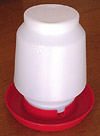 Clean, fresh water must ALWAYS be available to your chicks. Get at least a medium size waterer - chicks drink a LOT of water. We like this plastic kind, it's easy to clean, inexpensive, lightweight and they can't tip it over. They also poop everywhere including right into their water; clean the waterer at least once a day (depending on how crowded it is, even twice a day).
Clean, fresh water must ALWAYS be available to your chicks. Get at least a medium size waterer - chicks drink a LOT of water. We like this plastic kind, it's easy to clean, inexpensive, lightweight and they can't tip it over. They also poop everywhere including right into their water; clean the waterer at least once a day (depending on how crowded it is, even twice a day).
 Clean, fresh water must ALWAYS be available to your chicks. Get at least a medium size waterer - chicks drink a LOT of water. We like this plastic kind, it's easy to clean, inexpensive, lightweight and they can't tip it over. They also poop everywhere including right into their water; clean the waterer at least once a day (depending on how crowded it is, even twice a day).
Clean, fresh water must ALWAYS be available to your chicks. Get at least a medium size waterer - chicks drink a LOT of water. We like this plastic kind, it's easy to clean, inexpensive, lightweight and they can't tip it over. They also poop everywhere including right into their water; clean the waterer at least once a day (depending on how crowded it is, even twice a day).Feeders and Feeding
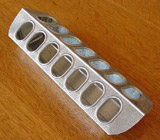 Even baby chicks will naturally scratch at their food, so a feeder that (more or less) keeps the food in one place is good. The feeder shown is a popular design made of galvanized steel; the top slides off to clean and fill it. Again, cleanliness is important; the chicks will poop right into their own food, so you must clean and refill it often.
Even baby chicks will naturally scratch at their food, so a feeder that (more or less) keeps the food in one place is good. The feeder shown is a popular design made of galvanized steel; the top slides off to clean and fill it. Again, cleanliness is important; the chicks will poop right into their own food, so you must clean and refill it often.
 Even baby chicks will naturally scratch at their food, so a feeder that (more or less) keeps the food in one place is good. The feeder shown is a popular design made of galvanized steel; the top slides off to clean and fill it. Again, cleanliness is important; the chicks will poop right into their own food, so you must clean and refill it often.
Even baby chicks will naturally scratch at their food, so a feeder that (more or less) keeps the food in one place is good. The feeder shown is a popular design made of galvanized steel; the top slides off to clean and fill it. Again, cleanliness is important; the chicks will poop right into their own food, so you must clean and refill it often.Chicks start out with food called "crumbles". It is specially formulated for their dietary needs; it comes both medicated or not. We know people that use either kind. If you don't use medicated feed, you run the risk that Coccidiosis will infect and wipe out as much as 90% of your chicks. If you choose non-medicated feed, pay more attention to cleanliness.
The feed is a complete food - no other food is necessary. However, feeding your chicks treats can be fun. After the first week or two, you can give them a worm or a bug or two from your garden to play with and eat. Greens are not recommended because they can cause diarrhea-like symptoms. When droppings are loose, a condition may develop called "pasting up", where droppings stick to the vent area and harden up, preventing the chick from eliminating. Check the chicks for pasting often - if you see this, clean off the vent area (you can use a moist towel or even some mineral oil).


















No comments:
Post a Comment